The following post is from Katie of Kitchen Stewardship: Storing bulk food the (easy? cheap? green?) way
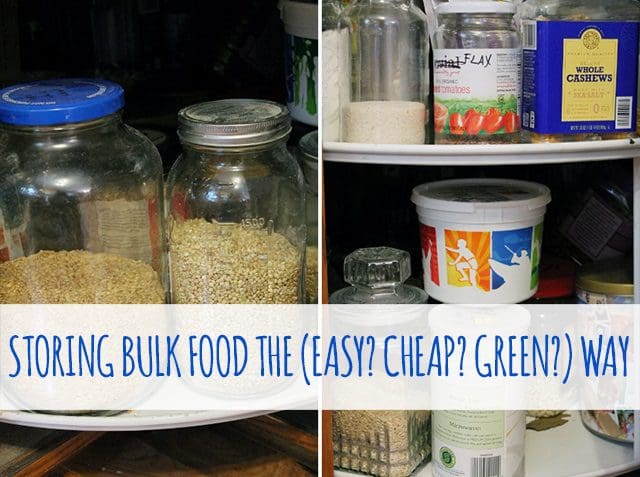
Buying food in bulk and preserving it from your garden and farmer’s markets is as an awesome way to save money and capture maximum nutrition. Still, there’s even one more reason to love those frugal habits: they reduce waste and help save the earth, too.
A 25-pound bag of dried beans uses far fewer packaging resources than 25 one-pound plastic bags, and the cans and shipping weight/fuel saved by making your own beans from dry has to be significant. In my household, all the bulk foods I buy also save me numerous trips to the store since I almost always have food in the house for plenty of meals without having to drive my van around and create pollution.
The last piece of the puzzle is how to store bulk foods in the safest way possible to keep the food from spoiling or getting eaten by critters and protect your family from potential leaching from questionable materials.
Readers often ask how I store bulk foods, and it’s probably not the best way to start a post but I’m going to be honest here: I really make it up as I go along and may not have the most efficient or perfect system. However – if you want to store your bulk foods frugally, I think you’ll find some nuggets of ideas in my basement. (You can do it “your way” in the true spirit of this site!!)
I buy dry goods in bulk from Country Life Natural Foods, including:
- dry beans
- oats
- whole grains
- nuts
- dried fruit
- starches and flours
- honey and sweeteners
- spices
I have various ways to keep the storage organized, safe from mice and bugs, and easy to access.
Welcome to my basement
I’ll take you on a little tour of our food storage “area” – pardon the lighting in the pictures as there’s really no great time of day for a basement and natural light!
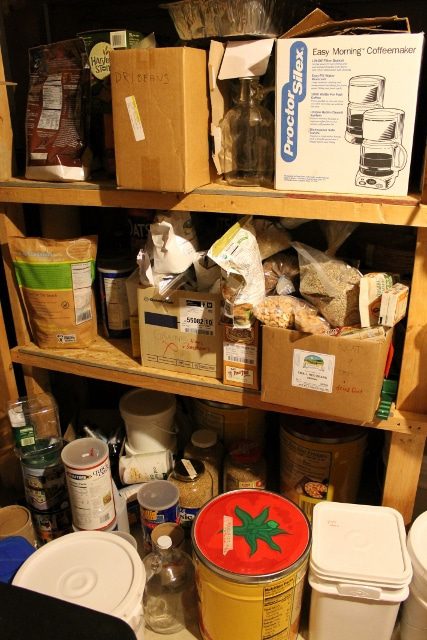
This is the whole scene, with some examples of very good and very bad food storage.
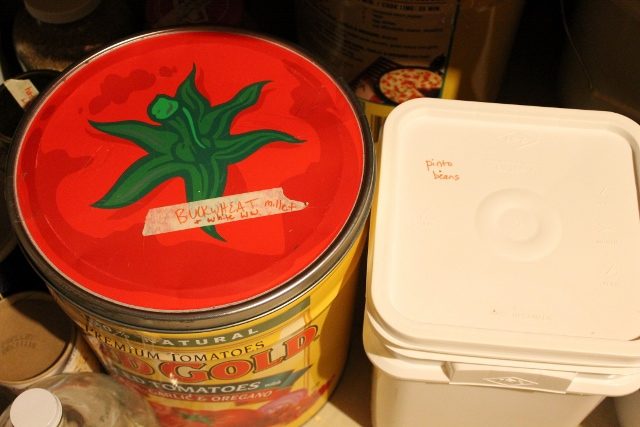
Most of the whole grains and beans come in large paper sacks, a perfectly safe material for my family’s health, but not exactly impervious to bugs and rodents. I prefer to sink those paper sacks into metal tins (like the Red Gold tins in the pictures, which were a freebie at some point – but you could also ask friends for the large popcorn tins that are so popular at Christmas time). I don’t worry about what the metal is made of because it’s not actually touching my food. Plus, as long as the bags fit inside the tins, I don’t have to bother with pouring and making a mess.
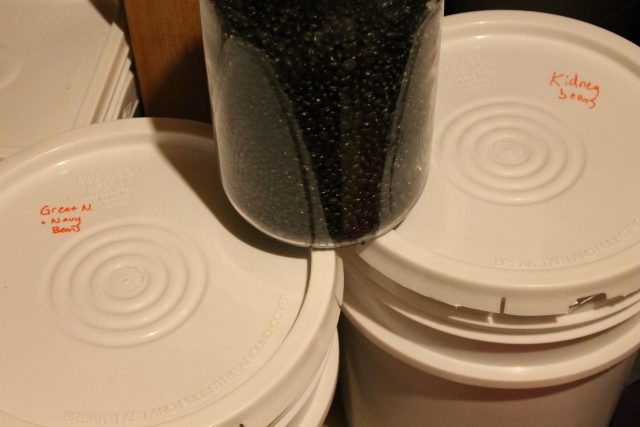
I have also purchased some plastic 5-gallon buckets designed specifically for food storage. They’re not cheap, usually $5-6 apiece, but they are food-safe plastic and protect the food well from rodents, insects or moisture. I generally pour my dry beans into them, and although plastic always has questions about leaching, I can’t imagine that much could leach into dry goods.
If you invest in the buckets, you must also invest in the special opener. It’s possible to get into the buckets without one, but it takes about 5 minutes and no small amount of frustration and sore fingers!
I also have a number of reused/reclaimed buckets from 10-pound purchases of Real Salt, bulk honey, and bulk coconut oil. I love repurposing them well and storing things like popcorn, homemade fruit rolls, and sweeteners I don’t use all that often. I’ve heard that some bakeries will allow people to take the large plastic buckets that frosting comes in, but I haven’t been able to work that out yet.
I store some bags in a large Rubbermaid tub, particularly the 50-pound bag of oatmeal I’m known to invest in. Possiblily, pantry moths could get through it, and I’ve known mice to gnaw through them as well, but that was in a garage during a hard winter. It’s not a perfect solution, but the oats are safe from moisture and critters. It’s the best I can do!
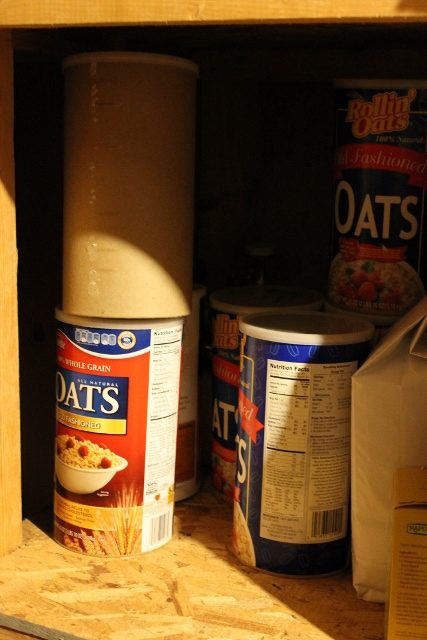
I store portions of oats for serving in the kitchen in old oatmeal canisters, which are certainly not safe from any of the three food disasters, but it’s a safe material, reused, free, and I’ve got to be able to access my oats without having to scoop from a huge bag every few days (we eat 5 cups at a time!) or purchase glass gallon jars at $6+ each. I only store them up off the floor, and any food on the floor is in thick plastic, glass or metal in case of a water problem in the basement.
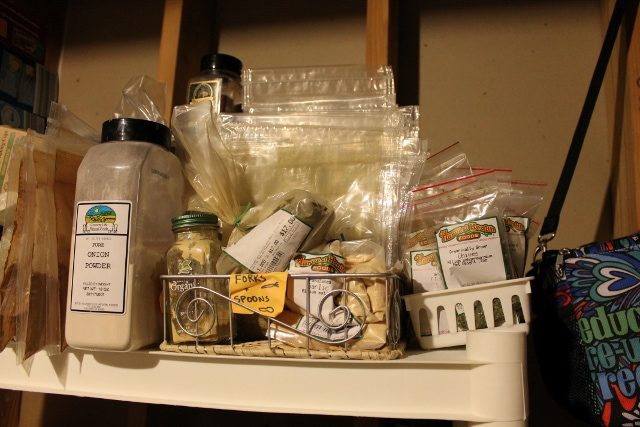
As for spices, I don’t repackage them until it’s time to refill my individual spice jars in the kitchen. I just try to organize them in alphabetical order so I don’t lose track of what I have – above are my two baskets, one for the wide bags from Penzey’s Spices and the other for the small one-ounce bags from our local health food store. I’ve never had a problem with longevity for spices, so I’m keeping my system for now.
The Big 3: Moisture, Rodents, Insects
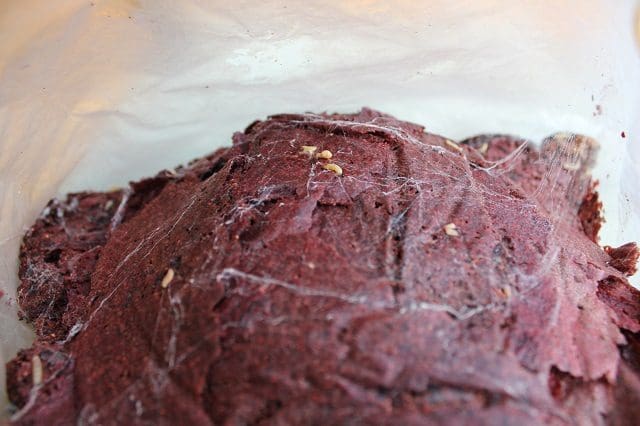
We had an experience I’d like to forget with some pantry moths last fall (above, my homemade dried strawberry fruit rolls and some visitors – feel free to cry with me!), and I learned that a plastic bag is not a safe place for food if you have that sort of infestation. After that, I reorganized a lot of my dry storage, particularly in the kitchen, so that moths couldn’t get into anything anymore.
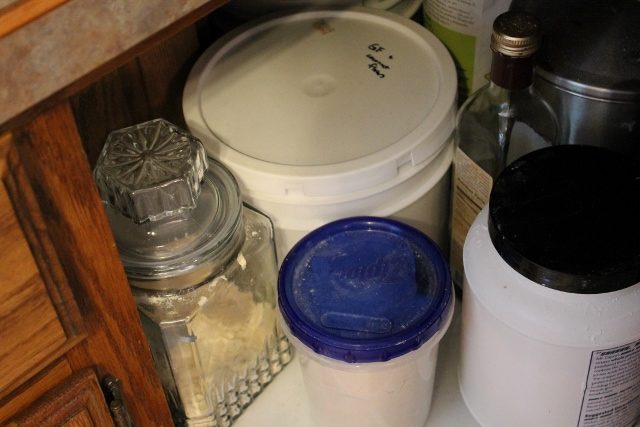

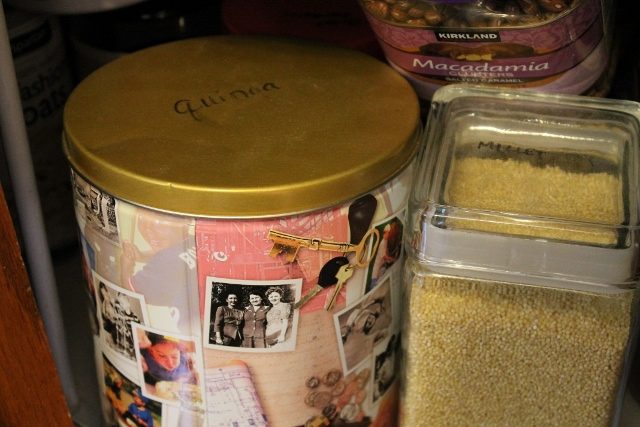
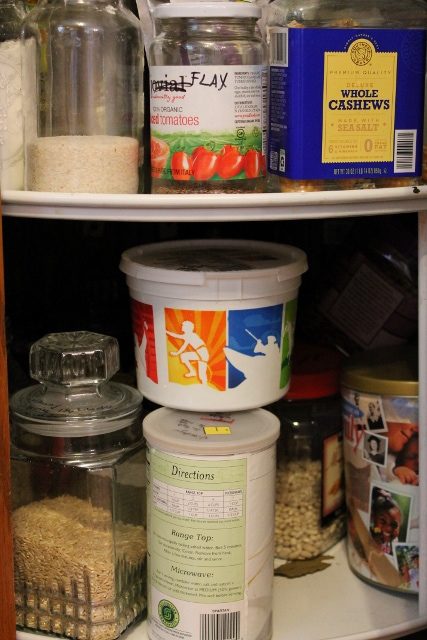
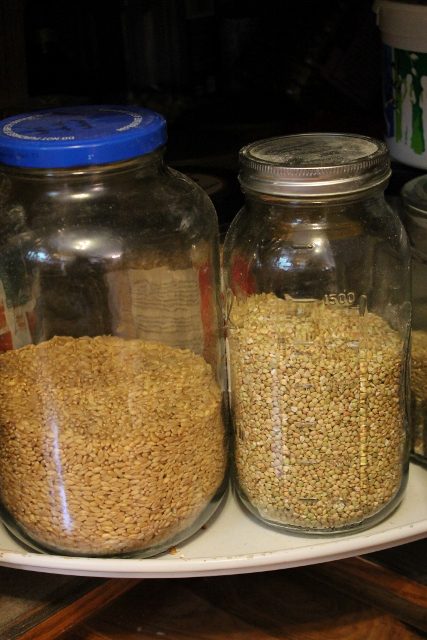
Now my dry beans and grains are all in glass jars, metal tins, or at the very least hard plastic containers with tight lids (rather than plastic bags). I source them from:
- Empty glass jars (my honey used to come in half-gallon canning jars, perfect for this purpose!)
- Costco-sized candy or nut plastic containers with screw-on lids
- Tins, but only when also in its own food-safe packaging
- A few purchased glass gallon jars, an investment, but nice for whole grains/beans – if you can get people at potlucks to give you the glass gallon-sized pickle jars, it’s a great freebie!!
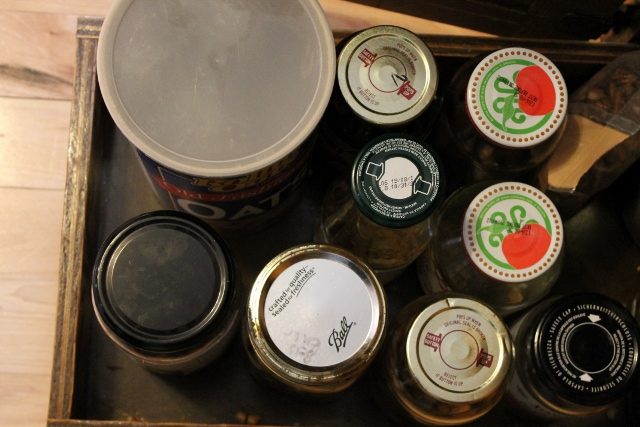
Our nuts and dried fruit for day-to-day access also got repackaged into glass jars, typically reused spaghetti sauce, applesauce, or tomato sauce jars. Not only are they safe from pantry moths, but they’re easier than zippered bags for my kids to open (and close!) and the shelf looks much more organized. I can easily tell when we’re low, and it’s not that big of a deal to refill jars. (They’re not labeled because it’s very easy to tell what is what from the side.)
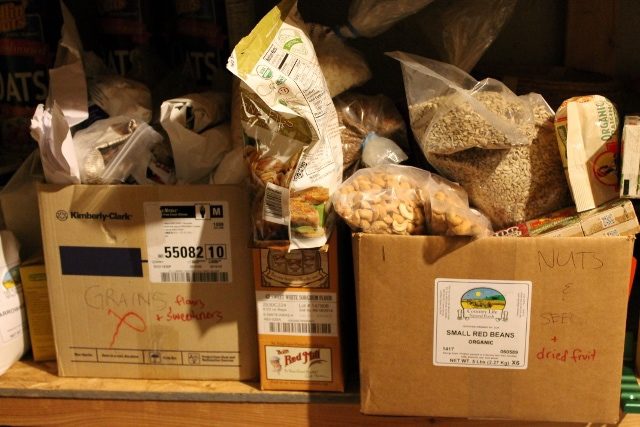
I don’t store everything very safely, I’ll admit. When dried fruit, sweeteners, and nuts come in 5-pound bags, I tend to just pile them up in boxes in the basement labeled with the type of food inside (chaos, above). I try to keep nuts in the freezer whenever there is room. They’re in plastic, but I do freeze in glass jars for as many liquids as possible. I should get some more large plastic tubs and sink them all in there for optimal safety, but it’s just something I haven’t done yet.
I do keep a pantry moth trap in the basement and check it every time I go into the storage room. If I ever find a moth in there, I’ll get scared and repackage everything and hope I’m not too late!
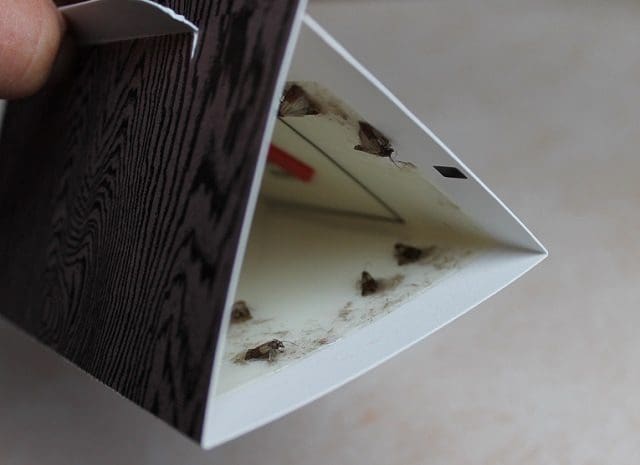
This is, of course, from my upstairs pantry where everything is under lock and key (i.e. hard plastic, glass, and metal). Except for boxes of pasta. And bags of tortilla chips. If I repackaged everything, we’d never have time to eat!
To recap, when I’m storing bulk foods, I take the following into consideration:
- Price: Can I repurpose something I already have or get a container for free that someone else would throw away?
- Impermeability: Glass and metal are the best defense against moisture and critters. Hard, thick plastic is next, and plastic bags aren’t a very good choice at all.
- Ease of access: I need to be able to get into my food for regular use within seconds.
- Safe materials: Glass and paper have no known health risks, some metals are rated very safe/non-leaching (stainless steel, for example), and plastic should be number 1, 4 or 5. Other recycle numbers have been proven to leach into food. All plastic should be seen as questionable, however, because we simply don’t know yet what we don’t know! I try to only store dry goods in plastic because liquids leach at a much faster rate.
If you’re buying in bulk and storing food, remember to label everything and keep track of what you have, both so that you don’t run out without being prepared and so you can use the oldest food first and never have to waste your investment.
Some helpful links for preserving your own from the harvest this time of year, a different way of having bulk foods on hand but usually just as helpful and economical:
- Easy home-canned tomatoes (avoid BPA-lined cans)
- How to dehydrate fruit (this is so easy! You’ll love buying inexpensive fruit in bulk.)
- How to dehydrate vegetables (if you’re running out of room in your freezer, dehydrated veggies are a super duper space saver to help waste nothing from your garden)
- Preserving produce by freezing
- 10 things I always keep in my freezer
- 5 tips for freezing everything
- How to store and freeze fresh produce, grains and more
- Tips for stockpiling “real food” — meats/proteins/fats, fruits and veggies, dairy products, grains
- 5 ways to preserve your apples (get ready for fall!)
Look for part two of this idea – how to store food using less plastic – next month when we discuss the refrigerator and how to store produce and leftovers as efficiently as possible.
Do you buy in bulk? How organized are you with your storage – and how safe from the “big 3” food disasters?
| Katie Kimball has been “green” since 5th grade when she read 50 Things Kids Can Do to Save the Earth. She remains slightly disappointed that she didn’t actually save the whole thing back then, but now that she has 3 kiddos counting on her, she keeps plugging away hopefully. Katie blogs at Kitchen Stewardship about real food and natural living and is the author of Healthy Snacks to Go and other eBooks, available for Kindle. | |



